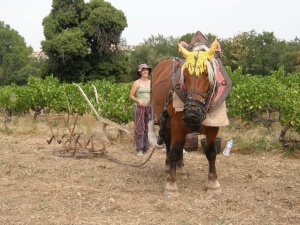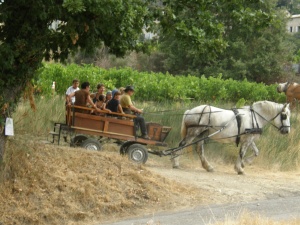Sorry for the sparse blogging this past month. I could give you the usual excuses — vacations, holidays, end-of-summer mental confusion, etc. Instead, I’m going to say that the hiatus was in solidarity with our wine producers in the Southern Rhône valley, where this year’s harvest is delayed by at least three weeks.

Who are you calling lazy? We temporarily suspended blogging in solidarity with our producers for their delayed harvest. That’s our story, and we’re sticking to it!
I got a hint that things might be a little out of the ordinary back in late May. The export manager for one of my producers e-mailed me about some labeling issues and closed with, “Please tell me it’s warm and sunny somewhere, because it isn’t here.” Normally it’s gorgeous weather in southern France that time of year. Sunny but not too hot during the day, beautifully cool at night. April can be iffy (the rains are bone-chilling) and June temperatures can already be in the 90s (mid 30s for you continentals). But May? Nothin’ but blue skies, like the song says.
Actually, I’m not sure there is ever a “normal” year when it comes to wine production. Harvest time is determined by the sugar content of the grapes and their flavor. In theory, this runs on a schedule that leads to a late August/early September harvest. If it has been a hot year, harvest is a little early; a cool year means it’s a little late. When you get outside that “little” bit, though, it can be problematic.
A really hot, dry year (like 2003 or 2009) can produce outstanding red wines with extra fruit and spice. But some of our producers decided not to make rosé in 2009 because the weather conditions caused higher-than-normal sugar content in the grapes even with an early harvest. In general, the higher the sugar content in the grapes, the more alcohol in the wine (assuming all the sugar is fermented into alcohol). That might be fine for a robust red, where there are plenty of other flavors to balance the alcohol burn. Rosés are supposed to have a lighter flavor, though, so a high alcohol content is not a good thing. Those producers decided to blend the Cinsault — the major constituent of their rosés — into their red wines instead.
On the opposite extreme, 2008 was cool and rainy. So even though the weather got better by the end of August, winemakers had to be selective about each and every grape. Plus the yields were low. The harvest was delayed and went on through mid-October, because growers wanted the grapes on the vine as long as possible for complete ripening. That must have been a nail-biter. Cy and I have frozen our butts off in mid-October in the Southern Rhône valley, so I can imagine there were universal hourly checks of the forecast. (As a weather geek Cy does this anyway, but it’s different when a year’s vintage depends on it.)

The harvest is late, but the harvest festivals go on, like this one in Séguret. Photo by Diane Simmons-Tomczak
Harvesting early is convenient in some ways. There’s less chance of bad weather before or during the harvest, which could either damage the crop or cause the grapes to absorb water and dilute the juice. But reducing the length of time the grapes spend on the vine can negatively affect flavor too. This is because some flavor components develop over time and are relatively independent of the specific weather conditions. Harvesting late increases the chance of cold weather and rain. It also pushes wine production later into the fall and early winter, which can cause delays in distribution.
But practically every vineyard has at least one microclimate and soil zone that’s different from the rest of the property – maybe even more than one. And winemakers have a lot of slight variations of technique they can use. So even less-than-ideal years can still produce some memorable wines. There were some slightly cooler areas producing great Cinsault for rosés in 2009, so cooperative wineries with access to a greater variety of vineyards (like Cave la Romaine and Cave la Vinsobraise) made outstanding 2009 rosés that were still amazing to drink in 2011. And while red grapes grown in poor clay soil with bad drainage did badly in a wet year (they’d otherwise create great wines in warmer, dryer weather), areas with well-drained soil did well. So Valérie Chaume-Arnaud was able to make a spectacular 2008 La Cadène Blanc that’s still hanging in there after most white wines are past their prime, if not spoiled.
I haven’t heard anyone say that the 2013 Southern Rhône harvest is problematic, other than being late. (Unlike some parts of France that had crop-destroying hail this year.) Things look pretty good for harvesting, weather-wise, so I’m looking forward to the usual wonderful whites and rosés arriving in March and April 2014, and excellent 2013 reds making an appearance in 2014-2015. Yes, those are a lot of superlatives. But with solidarity, you’re in all the way or not at all!
—————————

An old-time ride through the vineyards at the harvest festival in Séguret. Photo by Diane Simmons-Tomczak
So in spite of the afore-mentioned solidarity bravado, there has been a lot going on. Cy and I were on vacation for almost two weeks, then Dare, Mark, and their daughter were on vacation, and there was back-to-school and back-to-work stuff. Plus a new twist: the company we use for shipping delivered wine from only one of the two vineyards I had contracted for them to get to us. What with vacations and delays on their part we didn’t get the second producer’s wine for three more weeks.
It was especially disappointing because the missing wine was from Château de Clapier in the Luberon. I have a soft spot for Clapier’s wines because in addition to producing great wines, it was the first winery I found on my own to buy from for First Vine. I’ve mentioned before that the wines from Cave la Vinsobraise in Vinsobres were my first introduction to consistently marvelous southern Rhône wines. But tasting Château de Clapier Soprano red, made by Thomas Montagne, was another milestone altogether. And now we have the Soprano 2010, rested and ready to drink (and yours for $18). It’s 55% Syrah, 25% Grenache, and 20% Pinot Noir, and will only get better with time, for a long time. When Cy and I visited Thomas in 2010, we tried his 1999 Soprano and it was really something.
You really can’t go wrong food-wise with the Soprano. Cy and I have had it with any number of typical red-wine food pairings and it has never disappointed. But with a complex wine, simple food is often best. For example, grill an excellent steak and serve it with some mushrooms cooked with olive oil and shallots. But if you’re looking for a recipe, you can’t do much better than this one for Goat Cheese Tart. It’s a recipe I put in one of our very first First Vine newsletters, way back before we had this blog. And it’s the one that Dare and I give out most to people when they ask for recipes for in-home wine tastings. So please excuse the duplication if you’ve seen it before, but it’s definitely worth repeating. I found the recipe years ago, made a few changes, and have been making the tart ever since.
Goat cheese can be crumbly and dry on its own, but combining it with cream cheese helps make the tart filling smoother. Luckily, you can usually find logs of soft goat cheese that are just about 10 ounces in many supermarkets (an ounce more or less is fine), and cream cheese can be found in 3-ounce packages, so there’s nothing to weigh out. There aren’t a whole lot of other ingredients, so you really taste the tanginess and earthiness of the cheese. The cornmeal in the crust provides a nice contrast to the smooth filling, and you don’t have to roll out any pastry. The wide range in baking time is a result of variations in the amount of moisture in the goat cheese: depending on what you buy it can take more or less time to bake.
You may not feel like baking in our still-hot weather, but this tart is worth it. Bake it early in the day and let it sit at room temperature until serving, or do it a day ahead and cover and refrigerate it, then let the tart sit at room temperature for an hour. It will keep for a few days in the fridge and makes a great lunch.
As I mentioned in a previous post about Château de Clapier, Thomas Montagne told us he was distantly related to 19th century opera composer Ambroise Thomas. Mignon, his most famous opera, was a repertory staple through the 1950s but has fallen out of favor since then. Still, it’s full of great music and has three arias that everyone would recognize (they’ve been used in plenty of TV commercials). Two are for mezzos, and one is for soprano. So (carefully) open the wine, put your feet up, and watch Natalie Dessay in her high-soprano days tossing off “Je Suis Titania” like it was nothing. It’ll be tough to decide which is more thrilling — the Soprano wine, or the high F the soprano flings out at the end. Can’t go wrong either way!
Cheers!
Tom
Serves 8 – 10
Crust
1 cup all-purpose flour
1/2 cup cornmeal
1/2 teaspoon salt
6 tablespoons cold unsalted butter, plus extra for the pan
Butter the bottom and sides of a 9-inch springform pan. Mix the dry ingredients in a food processor, then cut the butter in small pieces, add to the mixture, and process in pulses until the mixture looks mealy and you don’t see any large pieces of butter. Press it into the bottom of the buttered pan and refrigerate for 20 minutes.
Filling
10 ounces soft goat cheese, at room temperature
6 ounces cream cheese, at room temperature
1/4 cup heavy cream
1 tablespoon flour
2 large eggs
Finely grated zest of one lemon
2 teaspoons fresh lemon juice
1 tablespoon chopped fresh thyme
2 tablespoons chopped fresh parsley
1/4 teaspoon freshly ground black pepper
Preheat oven to 350 degrees F. Mix the filling ingredients in a food processor until smooth. Pour into the pan onto the chilled crust. Bake 30 to 45 minutes, until a toothpick inserted into near the center comes out clean. Let cool and serve at room temperature.


Pingback: Terroirist: A Daily Wine Blog » Daily Wine News: Chinese Technology